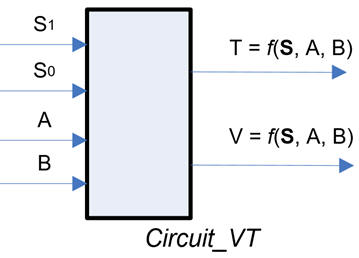|
|
|||||
Chapter 3 problems |
- B3.4 - |
Circuit_VT (μC - C) |
|||
|
|
|||||
1. Specifications
Design the combinational Circuit_VT in Fig. 1 using a microcontroller PIC18F4520.
This circuit was already presented as a combinational hardware design in D1.4.
 |
Fig. 1. Symbol and truth table of the circuit to be designed. Be aware that in this symbol, inputs S(1..0) are represented in multi-wire vector form and A and B are single wires. |
Draw an example of timing diagram to be used later as stimulus in the Proteus simulation of the circuit.
A) Planning hardware
Copy and adapt a circuit from any of the previous projects (LAB9) and name it Circuit_VT.pdsprj. Assign pins to inputs and outputs accordingly to one of the following options (your instructior will tell you which):
Pin assignment option #1:
S(1..0) --> RB(6..5)
A --> RA1 ; B --> RD3 ;
T --> RA2
V --> RC1
Pin assignment option #2:
S(1..0) --> RC(4..3)
A --> RB7 ; B --> RA3 ;
T --> RB6
V --> RD5
Pin assignment option #3:
S(1..0) --> RA(3..2)
A --> RD5 ; B --> RC2 ;
T --> RD6
V --> RB4
Project location:
C:\CSD\P9\Circuit_VT\(files)
B) Planning software
Organise the main program in our CSD way.
Propose a hardware-software diagram naming all the electrical signals, RAM variables and the software functions.
Explain how to configure the µC in init_system(). List all RAM variables required and their type.
Organise using a flowchart the interface function read_inputs().
Organise using a flowchart the interface function write_outputs().
Infer the truth_table() software function using a behavioural interpretation and the corresponding flowchart.
Developing & testing (debugging)
Write the Circuit_VT.c source code translating the function flowcharts. Start capturing only one input as in (LAB9) and visualising it in the watch window. And only then go step by step developing & testing more inputs.
Start a software IDE project for the target microcontroller PIC18F4520 and generate the configuration files ".cof" and ".hex" after compilation. Discuss the project summary: % of ROM used for the code, number of RAM bytes used, etc.
Add a few lines of code every time, compile and run the test intereactively to check results watching variables.
| Note: Step-by-step tactical approach for developing and testing the project: Read one input at a time and run to check that the voltage value is correctly captured as a valid digital value in RAM memory. Write one output at a time and run to check that your code is correct to light the LED connected at the output pin. |
Measure how long does it take to run the main loop code when using a 4 MHz and a 16 MHz crystall oscillators.



